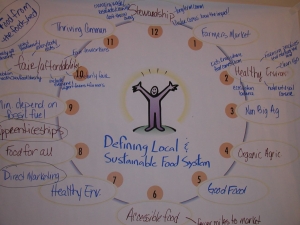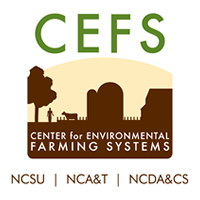To have your name added, contact Amber Polk at amber_polk@ncsu.edu.
Notes from the SUMMIT breakout sessions can now be found on the WIT pages linked below.
- F2F Core Team
- Game Plan
- Advisory Committee
- NC Food NETwork: a North Carolina Food System directory
- SUMMIT
- Working Issues
- Communications
- Community Gardens
- Direct Marketing
- Farm to School
- Local Government & Land Use
- New and Transitioning Farmer Support
- Processing & Food Systems Infrastructure
- Public Health & Food Access Disparities
- Retail & Institutional Markets
- Youth and Social Networking
- Formalizing the Initiative: Foundations & Baselines
- Regional Meetings
- How are we defining LOCAL?
- Regional Meetings Overview & Summary
- Triangle Region SUMMIT breakout session notes
- Mountain Region SUMMIT breakout session
- NorthEast Region SUMMIT breakout session notes
- Southeastern Region SUMMIT breakout session notes
- Triad Region SUMMIT breakout session notes
- Raleigh meeting
- Burgaw meeting
- Asheville
- Charlotte/Concord
- Winston-Salem
- Greenville
Golden Leaf Foundation
Z. Smith Reynolds
Ag Advancement Consortium
W.K. Kellogg Foundation
- CEFS
- Contact Information Form
- NC Choices
- NC Food Network
- Wayne Food Initiative
How are we defining LOCAL?
We've started each meeting with a discussion of sustainability and local—not trying to reach consensus, but rather bringing all the associated values and meanings to the table.

Describing local and sustainable
Here's what's being said:
A Local Food System is/means:
- Money at home
- Resiliant and adaptable, improves over time
- Willing farmers, produced and consumed in one locale
- Minimal waste: efficiency; conserves resources
- High quality; fresh
- Diversity of products and of markets
- Not genetically modified; heirlooms and open-pollinated
- Energy-efficient produce and transportation
- Environmentally friendly; not petroleum-dependent
- Four definitions, local and sustainable system, local and sustainable food
- Education, awareness, knowledge of value and access
- Economic awareness of cost
- Soil: clean; building more
A Local Sustainable Food Economy is/means:
- COMMUNITY-BASED
- Local gardens—everybody working together in a web to support farm to fork.
- CONSUMER EDUCATION
- cooking differently
- DIVERSE
- multiple products: vegetables, meat
- varieties
- UNDERSTOOD: TRANSPARENT
- information available to everyone
- INTEGRATED DECISION MAKING
- public policy, education solutions
- WELL-ROUNDED DIET
- broad range of foods locally
- HEALTHY
- nutrient-dense food
- AFFORDABLE ACCESSIBLE TO EVERYONE
- all levels, diversity
- needs to get to you
- FLEXIBLE
- adaptable
- new strategies to deal with financial crisis
- SUSTAINS LOCAL FARM FAMILIES
- PROFITABLE
- everybody involved
- PERMANENT
- sustainable, supports future members of family
- PROTECTS LAND, WATER, WILDLIFE
The phrases thrown out:
- Good for farmers
- Good for consumers
- Good for the environment
- Strong network that bridges
- Health benefits; good health
- Collaboration (working together)
- Inclusive, all walks of life can access; not just for the wealthy; also accessible by location
- Heritable tradition for production; sustainable for farmers
- Measurable system for reducing energy use, producing as much as your consumer
- Independence; self-sufficient (not dependent on foreign government)
- Entrepreneurship
- Benefits to bottom line; builds local economy
- Education/awareness for children
- Culturally appropriate food available
- Provides for and demands community investment
- Future-oriented; taking care of future generations
- Resilient to natural disasters
- Aesthetics beautiful to the consumer
- Aware consumers who understand where food comes from
- "Sweat equity" blending farmers and consumers
- Living wage and sustainable livelihood
- Define local: What is it?
- Any size as long as consumer and producers have a relationship
- Depends on how much farmer produces; small, more local needs
- Proximity to where grown and sold: county collards vs. North Carolina apples vs. Peruvian coffee
- Kids know where food comes from
- Farmers' markets everywhere
- Healthy environments
- Farming practices that nurture the land
- Nutrient and soil conservation
- Ecosystem balance
- Not "Big Ag"
- Organic agriculture
- Good food
- Food safety
- Accessible food
- Fewer miles to market
- Victory gardens; peace gardens
- Stable food supply
- Fewer miles to market
- Direct marketing
- Food for all
- Apprenticeships
- Minimum dependence on fossil fuel
- Fairness; affordability
- Protects biodiversity
- Everybody eats
- Fair to workers
- Culturally appropriate
- Monetarily fair and socially just
- Includes everyone and supports farms and farmers
- Correlations between health/food/obesity
- Culturally effective and relevant
- Food from the food shed
- Thriving community
- Stewardship
- Manages waste, resources and clean water; "don’t throw away"
- Long-term commitment
- Fewer consequences, know the impact
- "All produce and meat grown/raised within a radius of 100 miles. If the produce cannot be grown within 100 miles at a reasonable price (in the fullest sense of that word), then it is the closest reasonably priced produce."
- Good for seventh generations
- Independent
- Food that is nutritious
- Economically viable
- Profitable for public
- Resourceful
- Sustainable
- Community-building
- Buy-in from community
- Energy-efficient
- Resilient to crisis or unforeseen
- Abundant
- Eating more sunshine, less petroleum
- Attractive quality of life
- Restorative
- Supported by local policies
- Children know plants and want to grow them
- Apples over candy bars: irresistible
- A necessity
- Value for money
- Accessible; can physically get to purchase point
- Know who grew it—really local
- Healthy ecosystem
- Rooted in local history and culture
- Local as in 100-mile radius or two hours' drive
- Local depends on the product; native
- Buying as close to consumption as possible
- About relationships with farmers, earth
- Shaking hands with the grower
- Growing a satisfaction with foods that are native and seasonal
What do you want to add?
